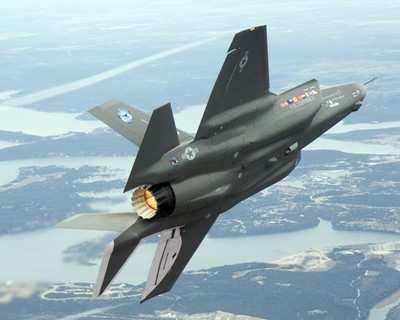Fri, Oct 19, 2007
BAE Systems Begins Work On Demonstrator Plane's Tail
Section
BAE Systems tells ANN it has started manufacture of the F-35
Lightning II Carrier Variant (CV). The CV aircraft is the final
F-35 variant to start production.

The initial manufacturing on the CV variant is of the first
titanium and aluminium frames that will form part of the aft
fuselage for the first CV aircraft, which is planned to take to the
skies in 2009. The aft fuselage and empennage for each F-35
Lightning II variant are being designed, engineered and built by
BAE Systems.
In addition to the CV, BAE is also working concurrently on the
conventional takeoff and landing (CTOL) version, as well as the
short takeoff and vertical landing (STOVL) F-35 variants.
"Developing three variants of the same aircraft, at the same
time, is a first for the military aircraft industry," said BAE
Systems' F-35 Lightning II Managing Director Tom Fillingham. "We
are breaking new ground on the F-35 program. Each variant has its
own unique challenges that have required some innovative solutions
from the team. Now that we have all three variants in manufacture
it is great to see all the design and engineering work coming
together."
The F-35 Lightning II program is the world's largest defense
program, and is currently in the System Development and
Demonstration (SDD) phase. The SDD phase will see the production of
21 test aircraft. Fifteen F-35s will undergo flight test, and six
will be used for static testing. Another high-fidelity full-scale
model F-35 will validate the aircraft's radar signature.
The aft fuselages for all variants of the F-35 are produced at
BAE Systems' Samlesbury facility in Lancashire, UK. As production
rates increase in the SDD phase, the BAE Systems team is starting a
new aircraft assembly every four weeks.
The three variants of the F-35 Lightning II are being developed
to meet the different performance requirements of the US and UK
armed forces. The Carrier Variant (CV) is being designed for the US
Navy, to cope with the demands of the catapult launches and
arrested landings on large US aircraft carriers. The Conventional
Take Off and Landing (CTOL) variant will meet the needs of the US
Air Force, while the Short Take Off and Vertical Landing (STOVL)
variant is being developed to meet the operational requirements of
the US Marine Corp and the UK.
More News
From 2014 (YouTube Version): One Of The Airshow World's Pre-Eminent Formation Teams Chats About The State Of The Industry At EAA AirVenture 2014, ANN News Editor Tom Patton gets th>[...]
Tactical Air Navigation (TACAN) An ultra-high frequency electronic rho-theta air navigation aid which provides suitably equipped aircraft a continuous indication of bearing and dis>[...]
Aero Linx: Doobert Hi, we're Chris & Rachael Roy, founders and owners of Doobert. Chris is a technology guy in his “day” job and used his experience to create Doobe>[...]
The Airplane Was Spinning In A Nose-Down Attitude Before It Impacted Terrain On June 20, 2025, at 0900 eastern daylight time, a Pitts Aerobatics S-2B, N79AV, was destroyed when it >[...]
Also: United Elite Sues, Newark ATC Transitions, Discovery Moves?, Textron @ KOSH The Commemorative Air Force Airbase Arizona is taking its “Flying Legends of Victory Tour&rd>[...]
 Classic Aero-TV: Up Close And Personal - The Aeroshell Aerobatic Team at Oshkosh
Classic Aero-TV: Up Close And Personal - The Aeroshell Aerobatic Team at Oshkosh ANN's Daily Aero-Term (07.13.25): Tactical Air Navigation (TACAN)
ANN's Daily Aero-Term (07.13.25): Tactical Air Navigation (TACAN) ANN's Daily Aero-Linx (07.13.25)
ANN's Daily Aero-Linx (07.13.25) NTSB Prelim: Pitts S2
NTSB Prelim: Pitts S2 Airborne 07.09.25: B-17 Sentimental Journey, Airport Scandal, NORAD Intercepts
Airborne 07.09.25: B-17 Sentimental Journey, Airport Scandal, NORAD Intercepts



